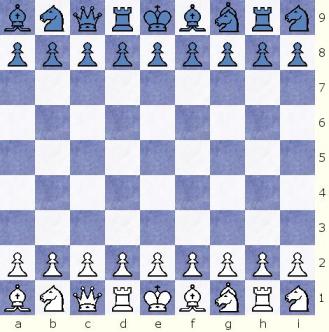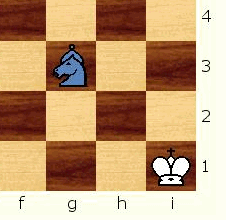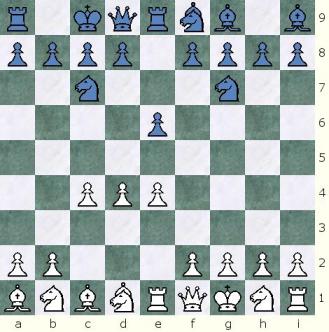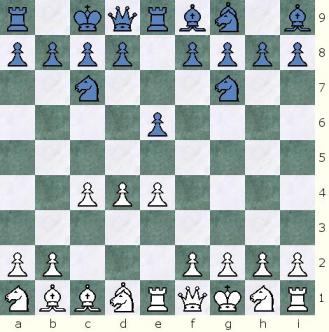Pseudo-Modern Random Chess
This page contains one or more presets for playing a game online with Game Courier, an online server for playing Chess variants by correspondence.
External image links detected!
You know what would look worse on your page than this big, ugly warning? Broken image links. If you're the author, please make sure that doesn't happen to this page by replacing the following external graphic images with local copies.
Array
(
[12] => http://frcec.chess960.info/FRC-Castling_files/image051.png
)

Simply stated, Pseudo-Modern Random Chess (P-MRC) is almost Modern Random Chess. The only difference is that instead of Reverse Symmetry, it uses Direct Symmetry accross the board.
Everything else is the same, 9x9 board, random position, Bishops allowed on the same color squares, Bishop Adjustment Rule, long symmetric castling to both sides of the board, the Prime Minister (B+N).
This game is like a "9x9 Fischer Random Chess" (well... almost, 9x9 FRC with the Bishop Adjustment rule).
Actually, Chess8400 is a 9x9 FRC that is a subset of Pseudo-Modern Random Chess (P-MRC). Chess8400 is the set of all P-MRC positions where Bishops startup in opposite square colors (8,400 positions).
Setup



All pieces are randomly placed in the player’s first rank, with the only restriction that the King must be between the two rooks. It is possible for both Bishops to be on the same color squares (dark or light squares). The opponents’ pieces are placed with direct symmetry across the board (White’s piece at a1 is equivalent to Black’s a9, White’s b1 to Black’s b9, White’s c1 to Black’s c9, and so on…)
There is a Bishop Adjustment rule that is in effect only in games when both Bishops start on the same color squares in the initial random setup. This rule allows players to move one of the Bishops to the opposite color, if they so desire.
There are 15,120 different legal starting positions in Pseudo-Modern Random Chess.
Pieces
Orthodox Chess pieces are used, plus a Prime Minister (Bishop+Knight) and a 9th Pawn per side.
Approximate Value of the Pieces on a 9x9 board
- Queen - 11 points
- Minister - 10 points
- Rook - 7 points
- Bishop - 4 points
- Knight - 4 points
- Pawn - 1 points
Practical Value of the Pieces (adjusted to an 8x8 board)
- Queen - 9 points
- Minister - 8 points
- Rook - 5 points
- Bishop - 3 points
- Knight - 3 points
- Pawn - 1 points
Gabriel Vicente Maura's Prime Minister (from his book Mathematical Thesis of Modern Chess):
Kings and their Prime Ministers
Homemade Prime Ministers
Knight crowned by small Bishop, Bishop crowned with small Knight, and a crownless King.
Knights crowned with the heads of Bishops.
The Prime Minister is the only piece that is able to give a checkmate on it's own. Sample Prime Minister's checkmates:


Rules
Most Orthodox Chess rules apply, including the objective of the game, the way pieces move and capture, en passant, check, checkmate, and the various draw situations (i.e. stalemate, insufficient mating material, threefold repetition, 50-move rule). Pawns may promote to a Queen, Minister, Rook, Bishop or Knight. Modified Castling rules are below, as well as the new Bishop Adjustment Rule.Castling
The P-MRC castling
rules are based in the Fischer Random Chess rules.
In Pseudo-Modern Random Chess, depending on the pre-castling position on the castling King and Rook, the castling manoeuvre is performed by one of these four methods:
- Double-move castling: By on one turn making a move with the king and a move with the rook.
- Transposition castling: By transposing the position of the king and the rook.
- King-move-only castling: By making only a move with the king.
- Rook-move-only castling: By making only a move with the rook.
After castling, the rook and king's final positions are exactly the same positions as they would be in Gabriel Vicente Maura’s 1968 Modern Chess. Thus, after c-castling (notated as O-O-Oc), the King is on the c-square (c1 for White and c9 for Black) and the Rook is on the d-square (d1 for White and d9 for Black). After g-castling (notated as O-O-Og), the King is on the g-square (g1 for White and g9 for Black) and the Rook is on the f-square (f1 for White and f9 for Black).
This table shows where the King and Rook end up and the notation for each type of castling.
| White castles a-side | c-castling | O-O-Oc | Kc1, Rd1 |
|---|---|---|---|
| White castles i-side | g-castling | O-O-Og | Kg1, Rf1 |
| Black castles a-side | c-castling | O-O-Oc | Kc9, Rd9 |
| Black castles i-side | g-castling | O-O-Og | Kg9, Rf9 |
However, castling may only occur under the following conditions, which are extensions of the standard rules for castling:
- Unmoved: The King and the castling Rook must not have moved before in the game, including a previous castling or a Bishop Adjustment.
- Un-attacked: All of the squares between the king's initial and final squares (including the initial and final squares) must not be under attack by any opposing piece.
- Vacant: All the squares between the king's initial and final squares (including the final square), and all of the squares between the rook's initial and final squares (including the final square), must be vacant except for the king and castling rook.
- Castling cannot capture any pieces.
- The king and castling rook cannot "jump" over any pieces other than each other.
- A player may castle at most once in a game.
- If a player moves his king or both of his initial rooks without castling, he may not castle during the rest of the game.
- In some starting positions, some squares can stay filled during castling that would have to be vacant in Modern Chess. For example, after c-castling (O-O-Oc), it's possible for to have a, b, and/or e still filled, and after g-castling (O-O-Og), it's possible to have e, h and/or i filled.
- In some starting positions, the king or rook (but not both) do not move during castling.
- In some starting positions, castling can take place as early as the first move.
- The King may not be in check before or after castling.
- The King cannot move through check.
- The King cannot jump over his own rook if and when said rook stands on a “checked†square. This point is best ilustrated by the sample Fischer Random Chess (Chess960) position below where it's illegal for White to g-castle (O-O) with it's e-Rook, as the King would need to jump over an attacked square. Even though the e-square is occupied by a Rook, it is under attack (or 'checked') by Black's Rook on e8.

- A King that has swapped places with a Bishop according to the Bishop Adjustment rule can no longer do castling for the rest of the game.
- A Rook that has swapped places with a Bishop according to the Bishop Adjustment rule can no longer castle with the King.
- Castling in P-MRC is symmetric to either side of the board. P-MRC Castling is like the Orthodox long castling (O-O-O) but to either side.
The Bishop Adjustment Rule
In those positions where the Bishops start up in the same color squares (either both on dark or light squares), players on their turn, are allowed to convert one (and only one) of their Bishops to the opposite color square by swapping places with any piece adjacent to them. Neither the Bishop nor the piece to be adjusted with may have moved before the Bishop swap. The Bishop adjustment will count as a single turn, and a move for both the Bishop and the piece swapped with.The Bishop Adjustment Rule is optional, and a player is not forced to use it. A player may choose to play with his Bishops on the same color squares if he so desires, even if his opponent chooses to adjust one of his Bishops. The Notation for the Bishop Adjustment is 'Bx <=> piece adjusting with', where x is the coordinate the Bishop is before the adjustment (i.e. Bc<=>Q stands for a Bishop on the c file adjusting with the Queen).
Note that the Bishop Adjustment rule has the following consequences in P-MRC:
- A Bishop on a corner may only adjust with the one piece adjacent to it.
- In addition to allowing the Bishop swap places with a Knight, the Queen or the Minister (like in Maura’s Modern Chess), it also allows the Bishop with a Rook, or the King!
- If the Bishop Adjusts with a Rook, that rook will be considered to have moved, and King Castling with that rook will no longer be possible. King Castling with the other Rook will still be possible provided neither the second Rook nor the King have moved.
- If the Bishop Adjusts with the King, the King will be considered to have moved, and King Castling will no longer be available for the rest of the game.
- When adjusting with the King, the Bishop Adjustment is considered to be a “Bishop†move, and not a King move that enables a player to move out of check. If the King is in check, it is not legal to move out of check with a Bishop Adjustment.
Sample Bishop Adjustments
José Carrillo - Luis MenéndezMRC position #2,264
May 2008
 ...
...
Position after 3... e6; and after 4.Ba<=>N Bg<=>M (both White and Black Adjust their Bishops on the 4th move)
Game Courier Preset
Pseudo-Modern Random Chess presetGame Courier Logs
Game Courier Logs for Games of Pseudo-Modern Random ChessTo see actual games that have been played on-line, follow the link above.
Chess Variants by the Author:
- Modern Random Chess (9x9)
- Contemporary Random Chess (8x8)
- Prime Ministers Chess (9x8)
- Modern Capablanca Random Chess (10x8)
- Modern English Random Chess (10x10)
- Pseudo-Modern Random Chess (9x9)
- Chess8400 (9x9)
- Prime Ministers Contemporary Random Chess (8x8)
- Prime Ministers Random Chess (9x8)
- International Contemporary Random Chess (10x10)
- International Fischer Random Chess (10x10)
- Courier Chess Moderno (12x8)
- Mini Courier Chess Moderno (10x8)
- Silver Elephant Chess (10x8)
- Modern Ministers Courier Chess (11x8)
- Ajax Chess (10x10)
- Partnership Chaturanga (8x8)
Other Pages by the Author:
- How to Generate Random Positions
- The Bishop Adjustment Rule
- The Modern Principles
- Reverse Symmetry
- The Prime Minister
- The Courier Elephant
- The 10x8 Variants
- Modern Chess Preset
- Makruk (Thai Chess) Preset
 This 'user submitted' page is a collaboration between the posting user and the Chess Variant Pages. Registered contributors to the Chess Variant Pages have the ability to post their own works, subject to review and editing by the Chess Variant Pages Editorial Staff.
This 'user submitted' page is a collaboration between the posting user and the Chess Variant Pages. Registered contributors to the Chess Variant Pages have the ability to post their own works, subject to review and editing by the Chess Variant Pages Editorial Staff.
By Jose Carrillo.
Web page created: 2008-08-08. Web page last updated: 2008-08-08
